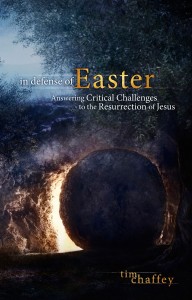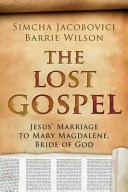Here we go again. Simcha Jacobovici’s new book, The Lost Gospel: Decoding the Sacred Text that Reveals Jesus’ Marriage to Mary Magdalene, is due out tomorrow (11/12/14). Based on the subtitle, it’s hard to imagine that the book won’t be stuffed full of distortions and outright lies.
Jacobovici is probably best known for his book, The Jesus Family Tomb, and corresponding film titled The Lost Tomb of Jesus. These works have been thoroughly discredited by conservative, liberal, and skeptical scholars alike. His conclusions were often built on falsehoods. I dedicated one chapter to refuting his claims in my book on the Resurrection (In Defense of Easter). But in a world where The da Vinci Code, with all of its revisionist history, sexism, conspiracy theories, and blasphemous slander of Jesus Christ and His church, can sell over 80 million copies, Jacobovici’s latest tome will undoubtedly find fertile soil to take root.
Although he makes many claims about archaeology and ancient texts, Jacobovici has no formal training in either field. He did earn an M.A. in International Relations and has made some successful documentaries.
Since the book will not be released until tomorrow, I have not been able to read it in its entirety so a full critique will not be made here. However, I have looked through the preview available on Amazon, and what I have read so far warrants plenty of skepticism toward the premise of the book. [Update: My full review of this book is now available online at Answers in Genesis.]
What Is this “Lost Gospel”?
The focus of The Lost Gospel is an ancient book called The Story of Joseph the Just and Aseneth his Wife. ((Simcha Jacobovici and Barrie Wilson, The Lost Gospel: Decoding the Sacred Text that Reveals Jesus’ Marriage to Mary Magdalene (New York, NY: Pegasus Books LLC, 2014), p. 4.)) Scholarly consensus has not been found concerning the book’s origin. The dating of the book has been placed anywhere from the first century BC to the sixth century AD. It is generally believed to be a Jewish work, but some scholars, like Richard Bauckham, believe it was written by a Christian.
Joseph and Aseneth reads much like other apocryphal books penned during or soon after the Second Temple period. If taken in a straightforward manner, the book provides a fictitious backstory to the life of Joseph’s wife Asenath, the daughter of Poti-Pherah mentioned in Genesis 41:50. Numerous spellings exist for her name depending upon the language of the manuscript used for translation. I will use the NKJV spelling, Asenath, unless I am referring to the title of the book, which spells her name as Aseneth.
According to the ancient tale, Asenath was the most beautiful woman in the land. This young virgin despised all of the suitors who sought her hand in marriage. Kept in a tower for much of her life and attended by seven maidens who shared her birth date, Asenath spent her time worshiping her false gods. Her parents arrived and told her she was to become Joseph’s wife. Asenath angrily refused such a proposition and returned to her chamber. Looking out the window, she saw Joseph and was instantly lovestruck. Upon being introduced to him by her father, Asenath attempted to kiss Joseph, but he rebuffed her since he used his mouth to bless God, and she used her lips to bless dead and dumb idols. Joseph took pity on her and prayed for her. She returned to her room, threw out all of her idols, fasted, mourned, and sat in ashes for seven days. On the eighth day, she was visited by an angel who told her that God had purified her and that she would become Joseph’s wife.
Joseph marries Asenath and they have two children, Ephraim and Manasseh. Then Pharaoh’s son, who had earlier sought to marry Asenath, plotted to kill Joseph and take her to be his wife. Scheming with some of Joseph’s brothers, Pharaoh’s son sought to kill his own father, but after being turned away by the guards, he was wounded by Benjamin, and eventually succumbed to his wound.
The story is kind of a fun read, and it provides some insight into how Joseph and his wife were viewed two millennia ago. The writer clearly knew the Old Testament and included some interesting details drawn from Genesis, Judges, and 1 Samuel. For example, Benjamin hurled a large round stone drawn from a brook and struck Pharaoh’s son on the left side of his forehead. This sounds like a mix between David and Goliath and the 700 left-handed Benjamites described in Judges 20:16 who were deadly stone slingers.
Is This Really a Lost Gospel?
But what does all of this have to do with a lost gospel? Nothing. Nothing at all! The Story of Joseph the Just and Aseneth his Wife is neither lost nor is it a Gospel. Professor Mark Goodacre has maintained an Aseneth web site since 1999. You can read the story for yourself on his site.
The subtitle explains the Jacobovici’s and Wilson’s goal. They have sought to “decode” Joseph and Aseneth so they can show the world that this ancient book was really about Jesus and Mary Magdalene being married and having two sons. It seems that the book will offer up the same tired lies that the male-dominated church of the first few centuries despised Mary Magdalene and attempted to bury the “truth” about her relationship with Jesus.

My book, In Defense of Easter: Answering Critical Challenges to the Resurrection of Jesus, examines the so-called Jesus Family Tomb. Available at the Midwest Apologetics store.
Heard this before? Of course you have. It’s the same story found in dozens of books from the past few decades, including The da Vinci Code and Jacobovici’s Jesus Family Tomb. Jacobovici has simply found another ancient document to distort and spring upon a largely biblically illiterate culture that loves conspiracy theories, particularly those that impugn Christ or His church.
Jesus was never married to Mary Magdalene or anyone else. This assertion has been made frequently, but all alleged support for such a notion crumbles. Two years ago, Dr. Karen L. King, a legitimate scholar, promoted the idea that she had been handed a fourth century fragment where Jesus mentioned His wife. The credit-card sized fragment is almost certainly a fake, and even if it were legitimate, it was written centuries after the biblical Gospels which were written by eyewitnesses or men who interviewed eyewitnesses. I have elsewhere published a response to Dr. King’s claims that provides five reasons we can be confident Jesus was not married.
Mary Magdalene was certainly a faithful follower of Christ, and she enjoys the unique privilege of being the first person to see the risen Savior, but this in no way makes her His wife. There was never any early church conspiracy to blot out her memory or anything of that nature.
Finally, even the Christian scholars who believe the Joseph and Aseneth may be an allegory about Jesus do not agree with Jacobovici. They do not believe it is about Mary Magdalene. Rather, they suspect that it may be an allegory about Jesus and His church.
Based on my own reading, the ancient writing seems to be just another interesting piece of fiction about biblical characters. These stories were fairly popular in New Testament times, sort of like historical fiction novels today. I’m willing to be corrected on this, but it has the hallmarks of these tales of Old Testament heroes.
Conclusion
Simcha Jacobovici seems like the type of guy who could charm your socks off. By all accounts I’ve read he is very friendly and likeable. However, these traits make his lies even more dangerous. This man has repeatedly spread lies about the Son of God. He has shown that he is more than willing to distort the facts. He has creatively cut interviews so that those who disagree with him are made to look like they support his conjectures. Sadly, his lies will be taken as gospel truth by people eagerly looking for ideas about Jesus that contradict Scripture.
Christians have no need to worry about his claptrap. The biblical Gospels of Matthew, Mark, Luke, and John have given us the truth about Jesus and His life. They explain that He was born of a virgin, lived a sinless life, died a sacrificial death on the Cross, and victoriously conquered the grave three days later.
I pray that rather than repeatedly slandering Jesus, Jacobovici would repent of his sins and call upon the loving and gracious Savior who gave His life so that even the vilest of sinners could be saved.

